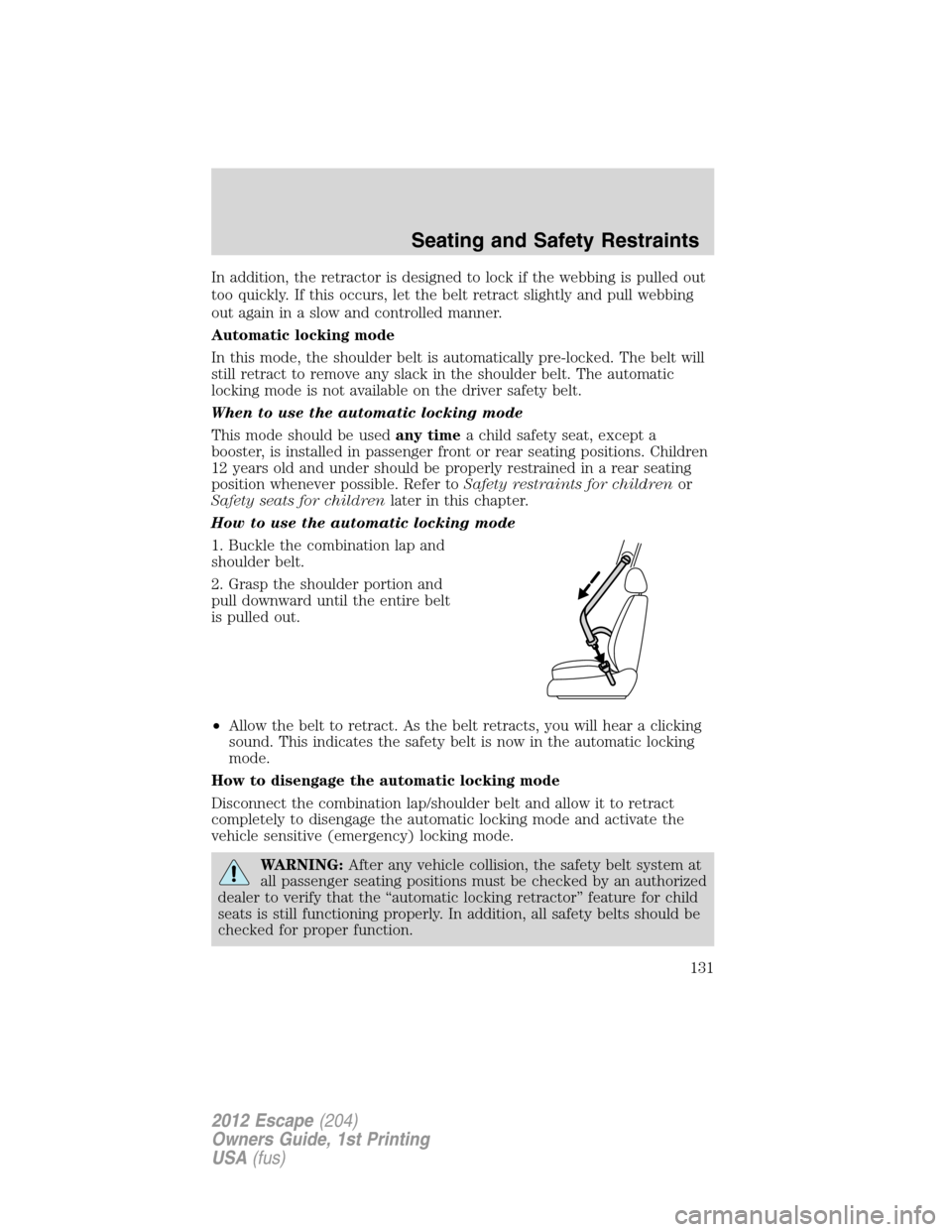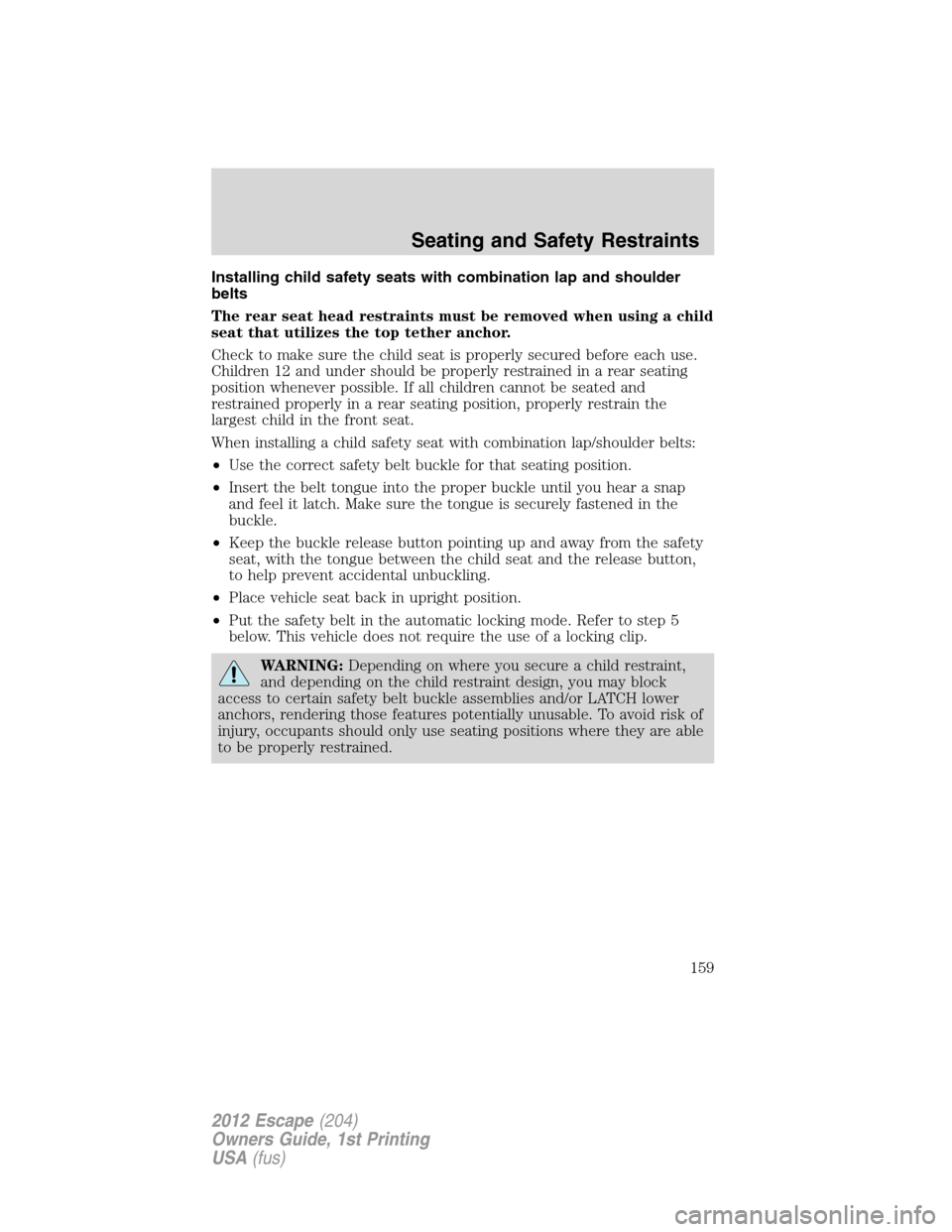Page 2 of 361
Locks and Security 92
Keys 92
Locks 98
Anti-theft system 108
Seating and Safety Restraints 112
Seating 112
Personal Safety System™ 124
Safety belt system 128
Airbags 138
Child restraints 154
Tires, Wheels and Loading 172
Tire information 174
Tire inflation 177
Tire Pressure Monitoring System (TPMS) 189
Vehicle loading 194
Trailer towing 201
Recreational towing 204
Driving 206
Starting 206
Brakes 212
AdvanceTrac�215
Transmission operation 224
Reverse sensing system 228
Rear-view camera system 230
Roadside Emergencies 245
Getting roadside assistance 245
Hazard flasher control 246
Fuel pump shut-off switch 247
Fuses and relays 247
Changing tires 254
Wheel lug nut torque 264
Jump starting 265
Wrecker towing 268
Table of Contents
2
2012 Escape(204)
Owners Guide, 1st Printing
USA(fus)
Page 10 of 361
These are some of the symbols you may see on your vehicle.
Vehicle Symbol Glossary
Safety Alert
See Owner’s Guide
Fasten Safety BeltAirbag - Front
Airbag - SideChild Seat Lower
Anchor
Child Seat Tether
AnchorBrake System
Anti-Lock Brake SystemParking Brake System
Brake Fluid -
Non-Petroleum BasedParking Aid System
Stability Control SystemSpeed Control
Master Lighting SwitchHazard Warning Flasher
Fog Lamps-FrontFuse Compartment
Fuel Pump ResetWindshield Wash/Wipe
Windshield
Defrost/DemistRear Window
Defrost/Demist
Introduction
10
2012 Escape(204)
Owners Guide, 1st Printing
USA(fus)
Page 11 of 361
Vehicle Symbol Glossary
Power Windows
Front/Rear
Power Window Lockout
Child Safety Door
Lock/UnlockInterior Luggage
Compartment Release
Panic AlarmEngine Oil
Engine CoolantEngine Coolant
Temperature
Do Not Open When HotBattery
Avoid Smoking, Flames,
or SparksBattery Acid
Explosive GasFan Warning
Power Steering FluidMaintain Correct Fluid
LevelMAX
MIN
Service Engine SoonEngine Air Filter
Passenger Compartment
Air FilterJack
Check Fuel CapLow Tire Pressure
Warning
Introduction
11
2012 Escape(204)
Owners Guide, 1st Printing
USA(fus)
Page 61 of 361
5. Disconnect the electrical
connector from the bulb.
WARNING:Handle a
halogen headlamp bulb
carefully and keep out of
children’s reach. Grasp the bulb
only by its plastic base and do not
touch the glass. The oil from your
hand could cause the bulb to
break the next time the
headlamps are operated.
6. Connect the electrical connector on the new bulb.
7. Insert the glass end of the new bulb into the headlamp assembly.
When the grooves in the plastic base are aligned, turn the new bulb
clockwise to install.
Replacing front parking lamp/turn signal bulbs
1. Make sure the headlamp control is in the off position.
2. Open the hood.
3. Reach over the front bolster.
4. Rotate the bulb socket
counterclockwise and remove from
the lamp assembly.
5. Carefully pull the bulb out of the
socket and push in the new bulb.
6. Install the bulb socket into the
lamp assembly and rotate clockwise.
Lights
61
2012 Escape(204)
Owners Guide, 1st Printing
USA(fus)
Page 102 of 361

CHILDPROOF DOOR LOCKS
When these locks are set, the rear
doors cannot be opened from the
inside. The rear doors can be
opened from the outside when the
childproof door locks are set, but
the doors are unlocked.
The childproof locks are located on
the rear edge of each rear door and
must be set separately for each
door.
Note:Setting the lock for one door
will not automatically set the lock
for both doors so you must set each
child lock on each door separately.
Insert the key and turn in the direction of arrow shown on the door to
engage the child proof lock. Turn in the opposite direction to disengage
childproof locks.
REMOTE ENTRY SYSTEM
The Integrated Keyhead Transmitter (IKT) complies with part 15 of the
FCC rules and with RSS-210 of Industry Canada. Operation is subject to
the following two conditions: (1) This device may not cause harmful
interference, and (2) This device must accept any interference received,
including interference that may cause undesired operation.
Changes or modifications not expressly approved by the party
responsible for compliance could void the user’s authority to
operate the equipment.
The typical operating range for your IKT is approximately 33 feet
(10 meters). A decrease in operating range could be caused by:
•weather conditions,
•nearby radio towers,
•structures around the vehicle, or
•other vehicles parked next to your vehicle.
Locks and Security
102
2012 Escape(204)
Owners Guide, 1st Printing
USA(fus)
Page 131 of 361

In addition, the retractor is designed to lock if the webbing is pulled out
too quickly. If this occurs, let the belt retract slightly and pull webbing
out again in a slow and controlled manner.
Automatic locking mode
In this mode, the shoulder belt is automatically pre-locked. The belt will
still retract to remove any slack in the shoulder belt. The automatic
locking mode is not available on the driver safety belt.
When to use the automatic locking mode
This mode should be usedany timea child safety seat, except a
booster, is installed in passenger front or rear seating positions. Children
12 years old and under should be properly restrained in a rear seating
position whenever possible. Refer toSafety restraints for childrenor
Safety seats for childrenlater in this chapter.
How to use the automatic locking mode
1. Buckle the combination lap and
shoulder belt.
2. Grasp the shoulder portion and
pull downward until the entire belt
is pulled out.
•Allow the belt to retract. As the belt retracts, you will hear a clicking
sound. This indicates the safety belt is now in the automatic locking
mode.
How to disengage the automatic locking mode
Disconnect the combination lap/shoulder belt and allow it to retract
completely to disengage the automatic locking mode and activate the
vehicle sensitive (emergency) locking mode.
WARNING:After any vehicle collision, the safety belt system at
all passenger seating positions must be checked by an authorized
dealer to verify that the “automatic locking retractor” feature for child
seats is still functioning properly. In addition, all safety belts should be
checked for proper function.
Seating and Safety Restraints
131
2012 Escape(204)
Owners Guide, 1st Printing
USA(fus)
Page 136 of 361

Reasons given... Consider...
�Traffic is light�Nearly 1 of 2 deaths occur in
single-vehicle crashes,many when
no other vehicles are around.
�Belts wrinkle my clothes�Possibly, but a serious crash can do
much more than wrinkle your clothes,
particularly if you are unbelted.
�The people I’m with don’t
wear belts�Set the example, teen deaths occur 4
times more often in vehicles with
TWO or MORE people. Children and
younger brothers/sisters imitate
behavior they see.
�I have an airbag�Airbags offer greater protection when
used with safety belts. Frontal airbags
are not designed to inflate in rear and
side crashes or rollovers.
�I’d rather be thrown clear�Not a good idea.Peoplewho are
ejected are 40 times more likely
to DIE.Safety belts help prevent
ejection, WE CAN’T�PICK OUR
CRASH�.
WARNING:Do not sit on top of a buckled safety belt or insert a
latchplate into the buckle to avoid the Belt-Minder�chime. To
do so may adversely affect the performance of the vehicle’s air bag
system.
Deactivating/activating the Belt-Minder�feature
The driver and front passenger Belt-Minder�are
deactivated/activated independently. When deactivating/activating
one seating position, do not buckle the other position as this will
terminate the process.
Read Steps1-4thoroughly before proceeding with the
deactivation/activation programming procedure.
Note:If you are using MyKey�, the Belt-Minder�cannot be disabled.
Also, if the Belt-Minder�has been previously disabled, it will be
re-enabled after the use of MyKey�. Refer toMyKey�in theLocks and
securitychapter.
Seating and Safety Restraints
136
2012 Escape(204)
Owners Guide, 1st Printing
USA(fus)
Page 159 of 361

Installing child safety seats with combination lap and shoulder
belts
The rear seat head restraints must be removed when using a child
seat that utilizes the top tether anchor.
Check to make sure the child seat is properly secured before each use.
Children 12 and under should be properly restrained in a rear seating
position whenever possible. If all children cannot be seated and
restrained properly in a rear seating position, properly restrain the
largest child in the front seat.
When installing a child safety seat with combination lap/shoulder belts:
•Use the correct safety belt buckle for that seating position.
•Insert the belt tongue into the proper buckle until you hear a snap
and feel it latch. Make sure the tongue is securely fastened in the
buckle.
•Keep the buckle release button pointing up and away from the safety
seat, with the tongue between the child seat and the release button,
to help prevent accidental unbuckling.
•Place vehicle seat back in upright position.
•Put the safety belt in the automatic locking mode. Refer to step 5
below. This vehicle does not require the use of a locking clip.
WARNING:Depending on where you secure a child restraint,
and depending on the child restraint design, you may block
access to certain safety belt buckle assemblies and/or LATCH lower
anchors, rendering those features potentially unusable. To avoid risk of
injury, occupants should only use seating positions where they are able
to be properly restrained.
Seating and Safety Restraints
159
2012 Escape(204)
Owners Guide, 1st Printing
USA(fus)